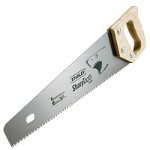Using a Saw
Author: steve Published Under: Home
 There
Thereis an important adage,"measure twice, cut once," which is often used when working with wood. This is important, as it prevents a lot of double work, as well as conserving wood. However, it is also important that you know how to work with a saw, so that you can produce a straight clean cut. Otherwise, even the most accurate measurements will not help you.
There are many types of handsaws and it is important to choose the right one for the job.
How to Use a Back Saw
Back saws have a strip of metal on the top of the blade, which keeps it rigid. This can be important for cutting joints and more accurate cuts.
To start with, it is important to cut at a shallow angle and pull the saw towards you at first. Keep the saw steady and press the thumb of the hand you are holding the wood with against the middle of the blade. This will help provide a guide.
Next, push the saw away from you, using very light pressure at first. Don't hold the saw too tightly and try to follow the knife line. Cut at a about a 10 or 15 degree angle, so that the top corner on the far side is cut first. Then, level out and follow the knife stroke.
If you have the right type of back saw for the job, the handle should be designed, so that you hold the saw at the correct angle.
How to Use a Traditional Hand Saw
Hand saws are not as accurate as back saws, so you can use a pencil to mark the wood instead of a knife. The process of using a handsaw is similar to using a back saw, but you start at a much higher angle.
Again, using your thumb as a guide, draw the saw to you and then push it away. The saw will begin cutting on the away stroke.
It is important that the waste, which is the side of the wood you do not need, is well supported, otherwise, it can make sawing more difficult and could damage the cut when it falls away.
Make sure to use the entire length of the hand saw and lower the angle after a few cuts. The saw should do most of the work, so don't use too much pressure. It is also important to reduce pressure slightly when you get to the tip of the blade and then exert more pressure during the middle.